I don’t often talk about my work as the Educational Content Creator for BrainPOP because a lot of what I do is behind the scenes stuff that probably isn’t that blog-worthy. But I absolutely have to share with you this really cool game that I’ve been working on with the GameUp team for months because I think it’s one of our most versatile and valuable tools to date.
First things first–if you aren’t familiar with BrainPOP’s GameUp, you totally should be. It’s a collection of games for math, science, ELA, health, and social studies (no subscription to BrainPOP required!) The GameUp team spends months vetting our partners and making sure that the games put on BrainPOP are top quality. They place a special emphasis on games that go beyond rote learning/drill and skill and into higher level thinking and synthesis of information in real world contexts.
Most of what’s on GameUp was created by partner organizations (including universities, museums, non-profits, and indie game developers), but some of the games are BrainPOP originals. Sortify is one of ours. It’s unique because it’s designed to be used as a playful assessment, and it’s open-ended and flexible enough to work for all grade levels (K-12) and many subject areas. Right now there are 13 different data sets for Sortify (you can see them all in the screenshot below) and more are continually being added.
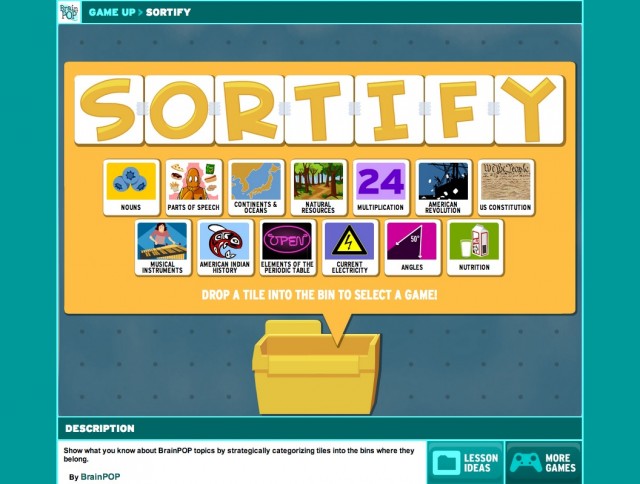
The goal of Sortify is to clear the whole board in as few rounds as possible. Students can also attempt to earn points, and try to beat their own score. First, they label their bins. The point value of each label is listed–the harder bin labels are worth more points. Then they click the “play” button and begin dragging and dropping tiles into the bins. When all tiles are sorted, they can check their answers and get instant feedback. When they click the “continue” button, incorrectly sorted tiles returned to the main area to be re-sorted so students can try again. The game is simple to play but takes a LOT of thought and reflection!
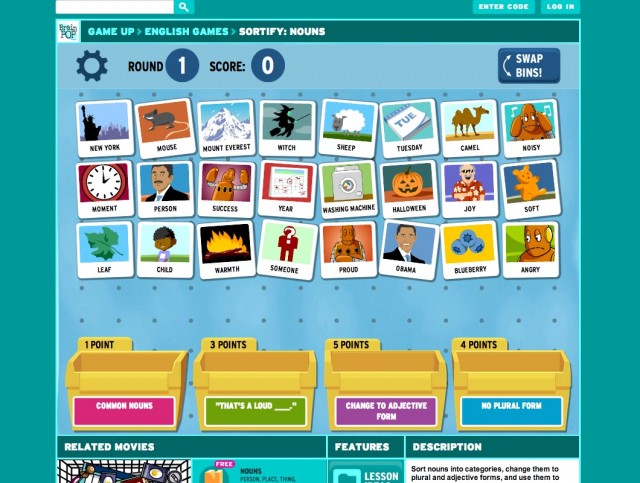
My job for each game is to create the Lesson Ideas Page (LIP). On the LIP for Sortify which is shown below, I’ve added a game trailer so you can see the game in action (yep, that’s me narrating!), some discussion starters to help you push kids’ thinking about their game strategies, and some tips and tricks for the game. I’ve also written an entire lesson plan full of ways you can use Sortify.
And this is possibly the best part of all: the GameUp team had the incredible idea to make an offline, paper-based version of the game so kids can create their own Sortify around any topic in the curriculum! Check out the Design Your Own Sortify Game page, where you can download the printable Game Designer Log and see a step-by-step slideshow I created to show how kids can make their game. We playtested the Design Your Own Sortify in some NYC schools and it was awesome to see how engaged the kids were and how it challenged their thinking.
Here’s how I would use Sortify with my own class: I would have students play the game in September using whichever data set tied in to my current standards. We’d probably play it whole class on the white board for a bit, and then I’d give kids a chance to explore the game with a partner. I’d wait a week or so and play Sortify again with a different data set, and this time have the kids play first with a partner and then independently. Once I was certain they understood the strategies, I’d introduce the Design Your Own activity and have students complete that in a group setting for a standards-based topic that isn’t one of the online data sets. Each group would have time to play each other’s game and talk about what worked and what didn’t. I would then integrate the Design Your Own activity on a monthly basis as an informal assessment or even review/test prep tool–I think the kids would really look forward to it and it would hone their critical thinking skills. I’d also have them play the online Sortify game whenever I taught a unit related to an existing data set.
So that’s a little bit of info about the work I do with BrainPOP part-time and also some updates about what’s new on the BrainPOP site. My co-workers are such a talented, creative, and hard-working group of people and I think they really hit it out of the park with Sortify . I can see it being used in so many different ways by teachers at every grade level, and I hope it’s something that you can integrate in your teaching in the fall!
Disclosure: I wasn’t compensated for this post in any way, and everything I write on The Cornerstone is always my own opinion and not endorsed by BrainPOP. I just love Sortify and am proud of our work on the game so I wanted to share!

Angela Watson
Founder and Writer
Discussion
Leave a Reply
OR

Join our
community
of educators
If you are a teacher who is interested in contributing to the Truth for Teachers website, please click here for more information.










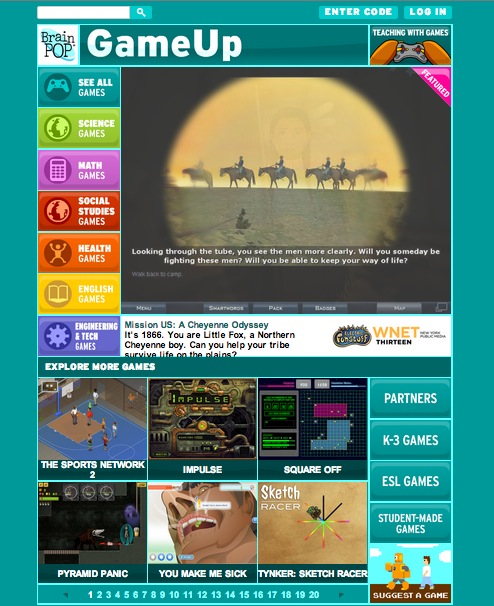
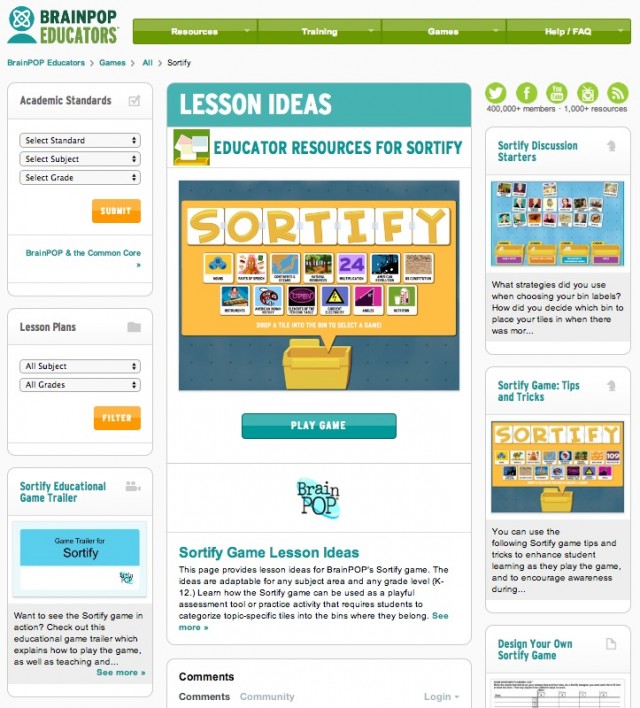
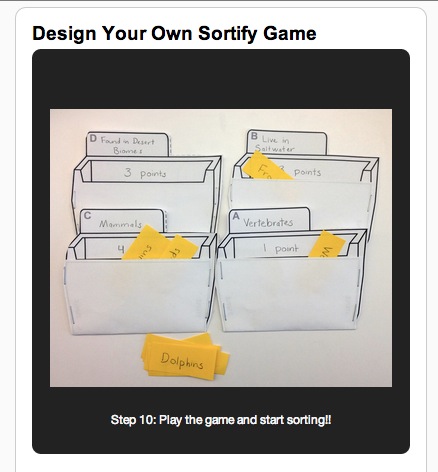






THANK YOU for this post! Our district has a BrainPop subscription, and just this past year I discovered Educators within the site – it took a while to get my subscription approved (glad to see it’s free for everyone now..good move, BrainPop!). Your post was a timely reminder of all that is available to our teachers. I am moving into a new position this year as a math/literacy instructional coach, and want to be able to let my teachers know what valuable tools are available to them. This was an incredibly helpful post!!
As an educator who recommends web 2.0 tools I was interested in trying these tools you are so excited about, but was quite disappointed that there was little information about the game is played. I tried it out, but soon gave up as I did not find it very user friendly.
Hi, Sylvia! Sortify has several pop-up screens at the beginning that explain game play. There’s also a lesson ideas page with a lesson plan and a game trailer so you can see the game in action: http://educators.brainpop.com/bp-game/sortify/. Hopefully those are helpful!
I have done play testing with 4th graders and found they were able to navigate the game on their own. You may want to give it a shot with your students and see how they do!
I stumbled upon Sortify in the Electric Circuits module of BP. I’m an educator and I like to try new things, but I’m far from being a gamer. I REALLY liked Sortify. I played it multiple times and I had to really think about what I was doing to get from a score of 41 to 60. Actual thinking is rare in click and drag games. Angela, you and your team should be proud.
I think this game could be used for teacher PD as well…to illustrate what instructional differentiation can look like in a game as it challenges learners at their level.
That is a cool idea! Thanks for sharing.